| Platylomia | |
|---|---|
 | |
| Platylomia viridimaculata | |
| Scientific classification | |
| Kingdom: | |
| Phylum: | |
| Class: | |
| Order: | |
| Suborder: | |
| Family: | |
| Genus: | Platylomia Stål, 1870 |
| Species | |
See text. | |
| Platylomia | |
|---|---|
 | |
| Platylomia viridimaculata | |
| Scientific classification | |
| Kingdom: | |
| Phylum: | |
| Class: | |
| Order: | |
| Suborder: | |
| Family: | |
| Genus: | Platylomia Stål, 1870 |
| Species | |
See text. | |
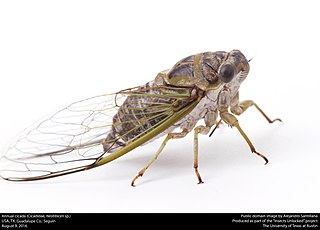
Cicadidae is the largest family of cicadas, with more than 3,200 species worldwide. The oldest known definitive fossils are from the Paleocene, a nymph from the Cretaceous Burmese amber has been attributed to the family, but could also belong to the Tettigarctidae.

Pomponia is a genus of cicadas from Asia. A group of species previously placed in Pomponia, containing the largest cicada species found on earth, have recently been moved to Megapomponia. However, the remaining species still form a very heterogeneous group and Duffels and Hayashi (2006) mentioned that several species should probably be transferred to genera like Terpnosia and Leptosemia.

The Cicadinae are a subfamily of cicadas, containing the translucent cicadas. They are robust cicadas and many have gaudy colors, but they generally lack the butterfly-like opaque wing markings found in many species of the related Tibiceninae.
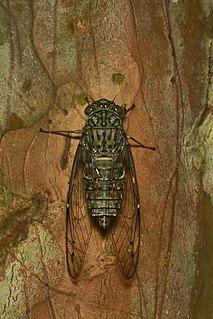
Purana is a genus of cicadas from Southeast Asia. Its distribution includes Java, Sumatra, Borneo, The Philippines, peninsular Malaysia, Thailand, India, Indochina, China, and Japan. Only one species has been recorded east of the Wallace Line, Purana celebensis, from Sulawesi. In all species the male possess two pairs of dark ventral abdominal tubercles on third and fourth sternites. The male opercula are rather short and generally do not reach beyond the posterior pair of tubercles. Related genera that also possess abdominal tubercles are Leptopsaltria, Maua, Nabalua and Tanna which together with Purana are in the subtribe Leptopsaltriina of the tribe Cicadini.
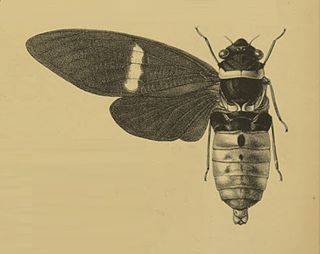
Tosena melanoptera is a cicada species from Southeast Asia. It was described by White in 1846 from material collected in North India. It has also been recorded from Thailand and Vietnam.

The Dundubiini are a tribe of cicadas in the family Cicadidae, found in the Palearctic, Indomalaya, Australasia, and the Western Pacific. There are at least 20 genera and 180 described species in Dundubiini.

Maua is a genus of cicadas from Southeast Asia. The males possess two pairs of dark ventral abdominal tubercles on third and fourth sternites.

Platylomia viridimaculata is a cicada species from Borneo and Peninsular Malaysia.

Cicadettinae is a subfamily of cicadas in the family Cicadidae. About 230 genera and 1,200 described species are placed in the Cicadettinae.
Champaka is a genus of cicadas in the family Cicadidae. There are about 12 described species in Champaka.
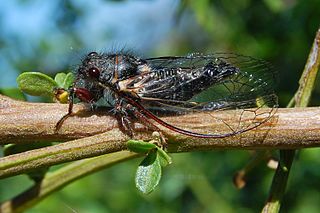
Tibicininae is a subfamily of cicadas in the family Cicadidae. There are 5 tribes and at least 140 described species in Tibicininae. They are found in the Neotropics, the Nearctic, and the Palearctic.
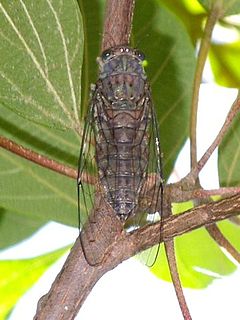
Leptopsaltriini is a tribe of cicadas in the family Cicadidae. There are at least 20 genera and 190 described species in Leptopsaltriini, found in the Palearctic, Nearctic, and Indomalaya.
Hyalessa is a genus of cicadas in the family Cicadidae, found in the Palearctic and Indomalaya. There are about 12 described species in Hyalessa.
Tibicinini is a tribe of cicadas in the family Cicadidae. There are about 8 genera and at least 100 described species in Tibicinini, found in the Holarctic.

Dundubia is a genus of cicadas in the subfamily Cicadinae and the type genus of the tribe Dundubiini.
Macrosemia is a genus of Asian cicadas in the tribe Dundubiini. Species records are from Taiwan and the eastern Asian mainland, including Indo-China.
| | This Cicadidae article is a stub. You can help Wikipedia by expanding it. |